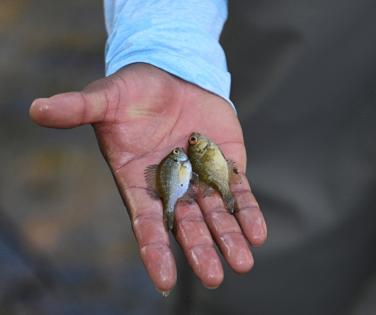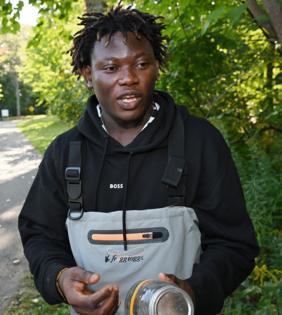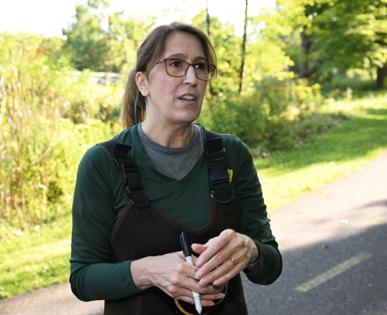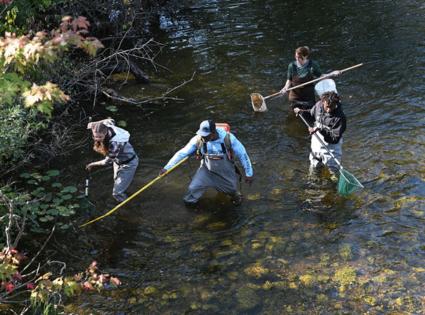Stalking a pollutant: Researchers comb river for secrets of Great Lakes microplastics
Published in News & Features
DEXTER TOWNSHIP, Mich. — Ali Shakoor took a break from his morning field work to lay two small bluegill in his palm, displaying the catch his colleagues had netted from a riffling nook of the Huron River.
The fish are opportunistic foragers. They fit squarely within the ecosystem in which Shakoor and a team Wayne State University researchers are searching for microplastics, a little-understood pollutant moving through Metro Detroit waterways and, likely, fish, animals and people as well.
"If microplastics are being moved by the fish, they're showing up in Lake Erie, people are catching those fish, and now those microplastics are making their way into humans," said Shakoor, a Wayne State doctoral candidate. "They're carrying different types of chemicals, hormone disruptors, chemicals that are used in tire manufacturing plants. This gives us a critical view into other aspects that may be impacting human health because we're basically, I mean, it sounds dramatic, but we're kind of under assault from all sides."
Shakoor and his colleagues descended on a quiet stretch of the Huron River in Dexter Township's Hudson Mills Metropark recently to collect samples of air, water, sediment, algae, bugs and fish. They planned to do the same at another site along the river in Brighton at the Island Lake Recreation Area.
The Wayne State teams are trying to answer major questions in microplastics research: How do the particles get into rivers, how do they move through the food web, and what chemicals are leaching off them.
Microplastics are tiny plastic particles that shed from anything containing plastic, such as grocery bags, medical equipment, paints, clothes, outdoor gear or car tires. They can get so small they are practically invisible.
The particles have become ubiquitous. Microplastics have infiltrated places as far-flung as coral skeletons and Antarctic snow, and as precious as human brain tissue, testes and placentas.
Though they have embedded themselves across the globe, the particles, their movement through ecosystems and the effects they have on people and the environment are not well understood, said Donna Kashian, director of environmental sciences and biology professor at Wayne State University.
Microplastics also also difficult to study, since they are a relatively new area of research, can be made with different chemical compounds and take different shapes, like beads or fibers, she said. But it's worth the effort since plastics have become so essential in places such as hospitals.
Other toxic compounds, such as PCBs, have been outlawed from production. While there's plenty of room to limit the use of single-use plastics, "there's no end in sight" for plastics entirely, Kashian said.
"So what we're seeing now is only really (microplastic pollution created) since the '70s when it went into huge production, the late '60s," Kashian said. "That's a small window. Now they're everywhere. In another 30 years, where are we? In another 30 years, where are we? And another 30 years? And we know very little still."
Students study microplastics' path
Microplastics pollution has caught the attention of the International Joint Commission, a binational commission of Canadian and U.S. leaders that guides the management and protection of the Great Lakes. The commission's science advisory team describes plastic pollution as "an emerging concern for Great Lakes water quality" and is developing frameworks for monitoring microplastics and determining the risks they pose. Kashian is a member of the IJC's Great Lakes Science Advisory Board.
The samples the Wayne State teams collect this month will provide a winter's worth of lab work, Kashian said. Her biology students will look for particles in the samples, an extensive process that requires dissection, high-level imaging and more. Students working with Zhijiang Lu, a Wayne State assistant professor who studies environmental contaminants, will look for chemical pollution that is associated with the microplastic particles.
Their analysis will shed light on what happens to microplastics when they hit a river, including whether they move up the food chain and, if so, whether they get more concentrated along the way.
"There's no location anywhere on Earth where anyone has gone in and done a total trophic level-wide analysis" of microplastics, Kashian said. "That's our goal here."
The samples students collect this month also will shed light on where the Huron River's microplastics come from.
Muritadah Oshinuga, a Wayne State master's biology student, has a hunch. Wearing a pair of waders, he gestured toward the North Territorial Road bridge over their Hudson Mills Metropark sampling site. Cars and large dump trucks rumbled by overhead.
"Those tires, they find their way into the waterbodies," Oshinuga said. "They have some effects on aquatic organisms."
Oshinuga is studying the effects tire particles have on aquatic insects, tiny fleas and worms that serve as a base of the food web in the Huron River. In the laboratory, he has seen that higher levels of tire particles are worse for the small creatures, stopping them from growing, reproducing or even surviving.
But that's in the lab. Oshinuga also wants to understand how many tire particles are actually in Metro Detroit waterways, and how those levels affect aquatic bugs.
"Nobody's actually looking at the effects of tire plastics, you know?" Oshinuga said. "The effect in the waterbodies. But they find their way (in) through the tear and wear of these tires. ... Not so much research has been done on that, so it's a good thing to actually try to look and see the effect of tire plastics and what it does to aquatic organisms in the environment."
Particles that shed off vehicle tires are even less understood than other microplastics, Kashian said.
But the problem has been out there for a long time. Vehicle tires are made out of lots of components, noted Sam Abuelsamid, a research analyst with Guidehouse Insights market advisory firm. That includes steel, natural and synthetic rubbers, carbon made from petroleum, nylon and other synthetics. Tires shed tiny pieces of those materials as they wear.
"You're driving down the road, and little particles get worn off your tires," Abuelsamid said. "Some of it gets airborne, because they're small enough to be airborne, but eventually it does fall to the ground because it has some mass to it. When it rains, those chunks of rubber get washed into the sewers and watersheds. So it gets into all kinds of places.
"It's a major source of microplastics in lakes and rivers and oceans."
When rubber meets the road
Heavier automobiles and electric vehicles, with their weighty batteries and considerable torque, tend to shed more particles from their tires, Abuelsamid said.
Additives in rubber, other tire components and microplastics leach out of the particles once they reach the environment, Lu said.
Lu and his students are studying the levels of chemicals associated with microplastics in the Huron River in conjunction with Kashian's students.
Detroit built the automobile and the metro region has "very heavy traffic," so it stands to reason that the region's rivers would carry some of the particles automobiles shed, Lu said. Where there is particle pollution, there is chemical pollution.
Lu and his students are specifically looking at 6PPD, a compound that prevents tires from breaking down but is toxic enough to kill some fish, including coho salmon, according to the U.S. Environmental Protection Agency.
The compound is used in all U.S. Tire Manufacturers Association passenger, light truck, truck, bus and motorcycle tires, according to a testimony the association's Executive Vice President Tracey Norberg gave to a U.S. Senate Subcommittee on Chemical Safety, Waste Management in July. There is no commercially available alternative, Norberg said.
But the association's members are working with the U.S. Geological Survey to find options that are safer for the environment, he said.
The association is "optimistic that we will have identified one or more possible alternatives that hold promise to replace or materially reduce 6PPD (the rubber preservative) in motor vehicle tires," Norberg said.
Ultimately, the findings from Wayne State students' microplastics research won't be about the water, algae, bugs or fish they collect this month, Shakoor said. It will be about people.
"In ecology, we're taught that everything is interconnected," Shakoor said. "So you can't have a healthy human population here when the ecosystem or the environment around that population is doing bad. Everything has to work in a symbiotic type relationship...
"We're just trying to see if this is indeed a pathway to humans and whether or not it could eventually impact human health."
©2024 www.detroitnews.com. Visit at detroitnews.com. Distributed by Tribune Content Agency, LLC.














Comments